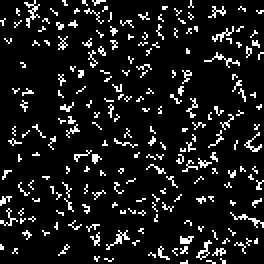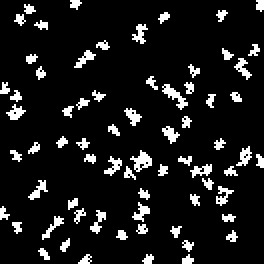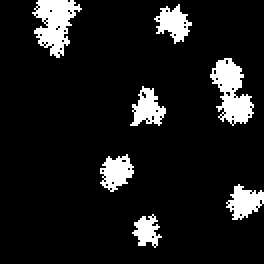This is an old revision of the document!
PHP's gd library is missing or unable to create PNG images
Spatial Patterns of Changes
As Dinamica EGO was designed to be a general purpose dynamic modeling software, we present a collection of spatial patterns produced by the various combinations of its transition functions. In order to evaluate the wide range of Dinamias’s possibilities, a series of simulation were run using synthetic simplified maps. The results for each model are presented as follows:
H0 to H8 are run, for a sole time step, by using a transition matrix 2×2 that models only one transition – from class 2 to 1 – with a rate of 0.01. The landscape map encompasses a matrix of 132 by 132 cells and all cells have equivalent spatial transition probability, which means that ancillary variables are not used to influence the cell allocation process.
| H0 | There is no spatial arrangement and no patch aggregation. The allocation process takes place randomly and does not interact with the neighborhood. The dynamics is only controlled by the transition matrix. |  |
| H1 | The allocation process is set to form patches with a patch mean size of five cells, patch variance is set to zero. Only the Patcher function is used. The Patcher isometry factor is set to zero, which means that the patches tend to be most linear as possible. |  |
| H2 | The allocation process is set to form patches with a patch mean size of five cells, patch variance is set to zero. Only the Patcher function is used. The Patcher isometry factor is set to 1, the patches still take linear form, though shorter. |  |
| H3 | The allocation process is set to form patches with a patch mean size of five cells, patch variance is set to zero. Only the Patcher function is used. The Patcher isometry factor is set to 1.5, now the patches assume a more isometric form. |  |
| H4 | The allocation process is set to form patches with a patch mean size of 20 cells, patch variance is set to zero. Only the Patcher function is used. The Patcher isometry factor is set to 1.5. Notice the fewer and larger patches. |  |
| H5 | The allocation process is set to form patches with patch mean size of 200 cells, patch variance is set to zero. Only the Patcher function is used. The Patcher isometry factor is set to 1.5. Only seven patches are formed. Patches tend to aggregate. |  |
| H6 | The allocation process is set to form patches with patch mean size of 20 cells, patch variance is set to 180. Only the Patcher function is used. The Patcher isometry factor is set to 1.5. Path size varies greatly. |  |
| H7 | Only the Expander function is used with patch mean size of 1742 cells, which is tantamount to the expected number of transitions. Patch variance is set to 0. The Expander isometry factor is set to 1.5. Notice the single patch produced around a cell of class 2 located at the center of the map. |  |
| H8 | The transition functions are used in a combination of 0.8 of Expander and 0.2 of Patcher. Patch mean size is set to 600 with patch variance of 0. The isometry factor is set to 1.5. Two more patches are produced around the expanded central cell. |  |








